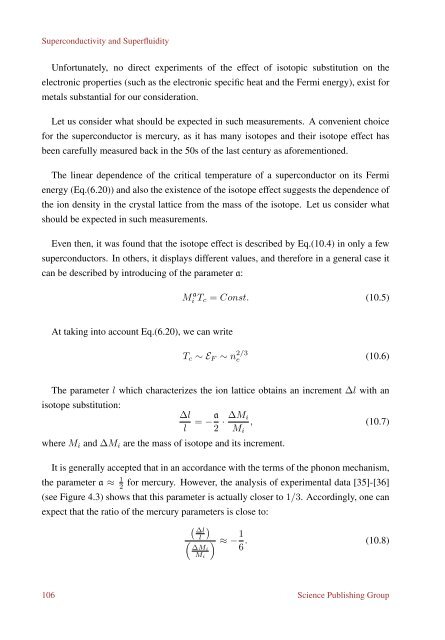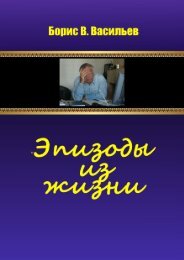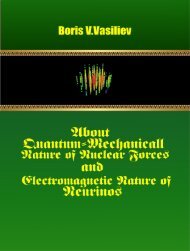978-1-940366-36-4_WholeBook
Boris V. Vasiliev Supercondustivity Superfluidity
Boris V. Vasiliev
Supercondustivity Superfluidity
You also want an ePaper? Increase the reach of your titles
YUMPU automatically turns print PDFs into web optimized ePapers that Google loves.
Superconductivity and Superfluidity<br />
Unfortunately, no direct experiments of the effect of isotopic substitution on the<br />
electronic properties (such as the electronic specific heat and the Fermi energy), exist for<br />
metals substantial for our consideration.<br />
Let us consider what should be expected in such measurements. A convenient choice<br />
for the superconductor is mercury, as it has many isotopes and their isotope effect has<br />
been carefully measured back in the 50s of the last century as aforementioned.<br />
The linear dependence of the critical temperature of a superconductor on its Fermi<br />
energy (Eq.(6.20)) and also the existence of the isotope effect suggests the dependence of<br />
the ion density in the crystal lattice from the mass of the isotope. Let us consider what<br />
should be expected in such measurements.<br />
Even then, it was found that the isotope effect is described by Eq.(10.4) in only a few<br />
superconductors. In others, it displays different values, and therefore in a general case it<br />
can be described by introducing of the parameter a:<br />
Mi a T c = Const. (10.5)<br />
At taking into account Eq.(6.20), we can write<br />
T c ∼ E F ∼ n 2/3<br />
e (10.6)<br />
The parameter l which characterizes the ion lattice obtains an increment ∆l with an<br />
isotope substitution:<br />
where M i and ∆M i are the mass of isotope and its increment.<br />
∆l<br />
l<br />
= − a 2 · ∆M i<br />
M i<br />
, (10.7)<br />
It is generally accepted that in an accordance with the terms of the phonon mechanism,<br />
the parameter a ≈ 1 2<br />
for mercury. However, the analysis of experimental data [35]-[<strong>36</strong>]<br />
(see Figure 4.3) shows that this parameter is actually closer to 1/3. Accordingly, one can<br />
expect that the ratio of the mercury parameters is close to:<br />
)<br />
(<br />
( ∆l<br />
l<br />
∆M i<br />
M i<br />
) ≈ − 1 6 . (10.8)<br />
106 Science Publishing Group













